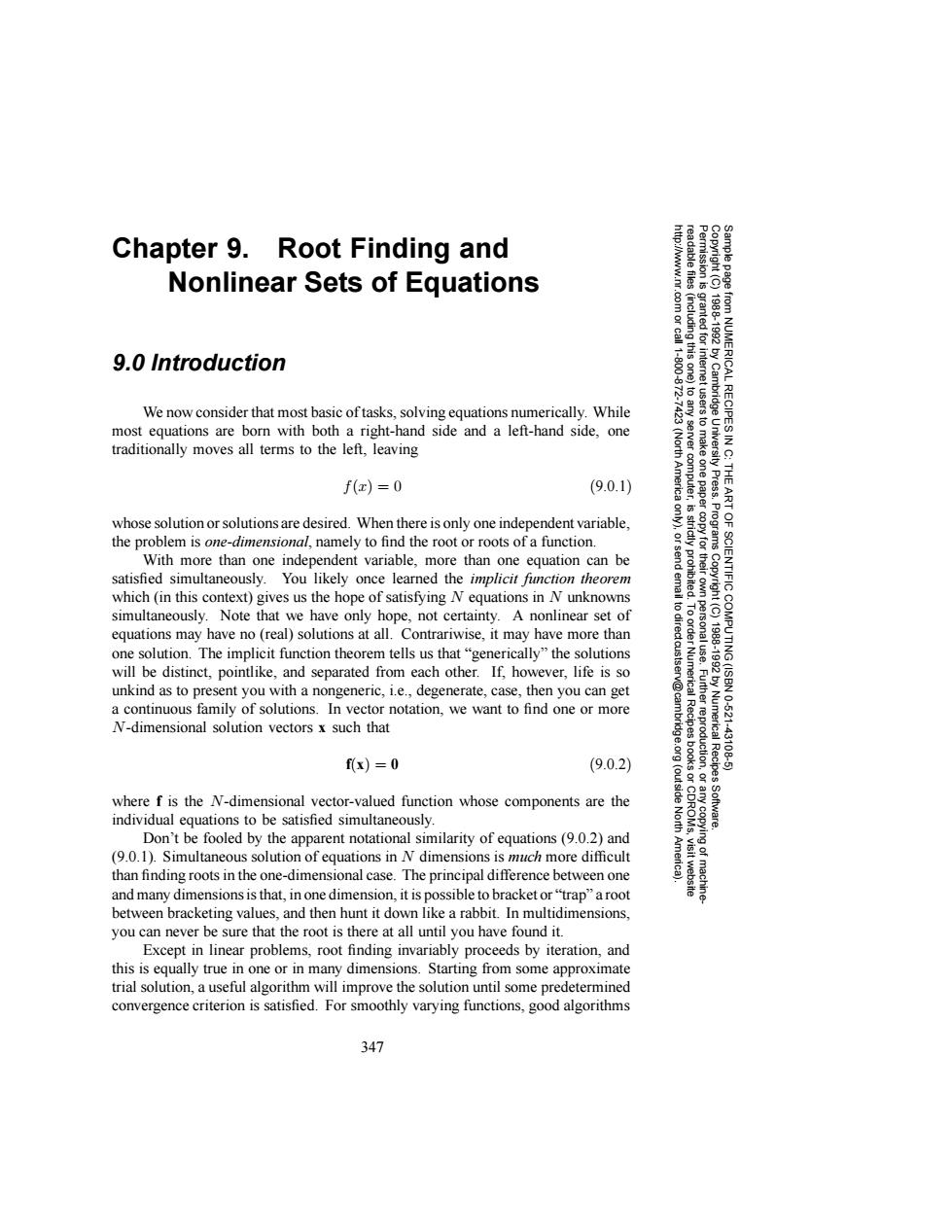正在加载图片...

Chapter 9.Root Finding and Nonlinear Sets of Equations http://www.nr. .com or call 9.0 Introduction NUMERICAL Cambridge We now consider that most basic oftasks,solving equations numerically.While most equations are born with both a right-hand side and a left-hand side,one traditionally moves all terms to the left,leaving f(x)=0 (9.0.1) 9是%> compu Press. C:THEA whose solution or solutions are desired.When there is only one independent variable. the problem is one-dimensional,namely to find the root or roots of a function. 8 With more than one independent variable,more than one equation can be satisfied simultaneously.You likely once learned the implicit function theorem SCIENTIFIC which(in this context)gives us the hope of satisfying N equations in N unknowns simultaneously.Note that we have only hope,not certainty.A nonlinear set of 6 equations may have no(real)solutions at all.Contrariwise,it may have more than one solution.The implicit function theorem tells us that"generically"the solutions will be distinct,pointlike,and separated from each other.If,however,life is so unkind as to present you with a nongeneric,i.e.,degenerate,case,then you can get r Numerical a continuous family of solutions.In vector notation,we want to find one or more Recipes (N06211 N-dimensional solution vectors x such that f(x)=0 (9.0.2) ecipes where f is the N-dimensional vector-valued function whose components are the (outside individual equations to be satisfied simultaneously. North Software. Don't be fooled by the apparent notational similarity of equations(9.0.2)and (9.0.1).Simultaneous solution of equations in N dimensions is much more difficult than finding roots in the one-dimensional case.The principal difference between one America visit website and many dimensions is that,in one dimension,it is possible to bracket or"trap"a root machine- between bracketing values,and then hunt it down like a rabbit.In multidimensions. you can never be sure that the root is there at all until you have found it. Except in linear problems,root finding invariably proceeds by iteration,and this is equally true in one or in many dimensions.Starting from some approximate trial solution,a useful algorithm will improve the solution until some predetermined convergence criterion is satisfied.For smoothly varying functions,good algorithms 347Permission is granted for internet users to make one paper copy for their own personal use. Further reproduction, or any copyin Copyright (C) 1988-1992 by Cambridge University Press. Programs Copyright (C) 1988-1992 by Numerical Recipes Software. Sample page from NUMERICAL RECIPES IN C: THE ART OF SCIENTIFIC COMPUTING (ISBN 0-521-43108-5) g of machinereadable files (including this one) to any server computer, is strictly prohibited. To order Numerical Recipes books or CDROMs, visit website http://www.nr.com or call 1-800-872-7423 (North America only), or send email to directcustserv@cambridge.org (outside North America). Chapter 9. Root Finding and Nonlinear Sets of Equations 9.0 Introduction We now consider that most basic of tasks, solving equations numerically. While most equations are born with both a right-hand side and a left-hand side, one traditionally moves all terms to the left, leaving f(x)=0 (9.0.1) whose solution or solutions are desired. When there is only one independent variable, the problem is one-dimensional, namely to find the root or roots of a function. With more than one independent variable, more than one equation can be satisfied simultaneously. You likely once learned the implicit function theorem which (in this context) gives us the hope of satisfying N equations in N unknowns simultaneously. Note that we have only hope, not certainty. A nonlinear set of equations may have no (real) solutions at all. Contrariwise, it may have more than one solution. The implicit function theorem tells us that “generically” the solutions will be distinct, pointlike, and separated from each other. If, however, life is so unkind as to present you with a nongeneric, i.e., degenerate, case, then you can get a continuous family of solutions. In vector notation, we want to find one or more N-dimensional solution vectors x such that f(x) = 0 (9.0.2) where f is the N-dimensional vector-valued function whose components are the individual equations to be satisfied simultaneously. Don’t be fooled by the apparent notational similarity of equations (9.0.2) and (9.0.1). Simultaneous solution of equations in N dimensions is much more difficult than finding roots in the one-dimensional case. The principal difference between one and many dimensions is that, in one dimension, it is possible to bracket or “trap” a root between bracketing values, and then hunt it down like a rabbit. In multidimensions, you can never be sure that the root is there at all until you have found it. Except in linear problems, root finding invariably proceeds by iteration, and this is equally true in one or in many dimensions. Starting from some approximate trial solution, a useful algorithm will improve the solution until some predetermined convergence criterion is satisfied. For smoothly varying functions, good algorithms 347